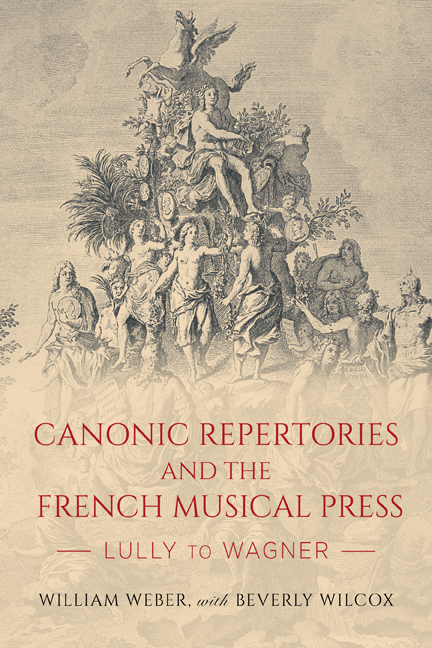Book contents
- Frontmatter
- Contents
- Acknowledgments
- List of Illustrations
- Introduction
- 1 The Domestic versus the Foreign in Eighteenth-Century Paris and London
- 2 Elements of Canon Formation at the Concert Spirituel (Beverly Wilcox)
- 3 To Praise or to Criticize? The Evolution of Music Criticism in Eighteenth-Century France
- 4 Haydn in the Press during the 1780s: How Did a Canon Arise?
- 5 Parallel Canons at the Opéra and the Comédie-Française at the End of the Ancien Régime
- 6 Negotiating Canonic Repertory and les progrès de la musique at the Paris Opéra, 1815–1830
- 7 The Evolution of le vieux répertoire at the Opéra-Comique in the Nineteenth Century
- 8 Richard Wagner, Concert Life, and Musical Canon in Paris, 1860–1914
- An Afterword
- Bibliography
- Index
2 - Elements of Canon Formation at the Concert Spirituel (Beverly Wilcox)
Published online by Cambridge University Press: 26 May 2022
- Frontmatter
- Contents
- Acknowledgments
- List of Illustrations
- Introduction
- 1 The Domestic versus the Foreign in Eighteenth-Century Paris and London
- 2 Elements of Canon Formation at the Concert Spirituel (Beverly Wilcox)
- 3 To Praise or to Criticize? The Evolution of Music Criticism in Eighteenth-Century France
- 4 Haydn in the Press during the 1780s: How Did a Canon Arise?
- 5 Parallel Canons at the Opéra and the Comédie-Française at the End of the Ancien Régime
- 6 Negotiating Canonic Repertory and les progrès de la musique at the Paris Opéra, 1815–1830
- 7 The Evolution of le vieux répertoire at the Opéra-Comique in the Nineteenth Century
- 8 Richard Wagner, Concert Life, and Musical Canon in Paris, 1860–1914
- An Afterword
- Bibliography
- Index
Summary
A canon at the Paris Concert Spirituel evolved, between the founding of the unique concert series in 1725 and its tumultuous end in 1790, somewhat differently than at the Académie Royale de Musique. Both organizations were state monopolies with the management farmed out to entrepreneurs. The concerts were considered to be among the Parisian “Spectacles,” entertaining up to 900 listeners each night, but, unlike performances at the Opéra, they were not spectacular enough to play a role in glorifying the state or to amuse the fast crowd, known at that time as le beau monde. As a result, the entrepreneurs could expect no financial help in time of trouble; they had to construct programs that would make a profit and stood to lose everything if they failed, and as a result they had to cater to the tastes of the majority of the public in order to fill the seats. The performance schedule of the Concert Spirituel was limited as well; its approximately twenty-five concerts per year were limited to the days when the theatres were closed: feast days and the weeks surrounding Easter. Still, in addition to sacred motets for soloists, chorus and orchestra, the programs included concertos, Italian arias, symphonies, and oratorios. A rich trove of data about these programs survives: concert listings and reviews in Paris periodicals for its entire sixty-five-year history, a complete repertory list from the early 1750s, and inventories of several of the entrepreneurs’ music libraries.
Contemporary writers such as Titon du Tillet and Pierre-Louis Daquin spoke of many of the composers in the Concert Spirituel repertory (see table 2.1 below) in terms implying canonicity: they had created “a corpus of old and revered works, models for emulation and taste.” Their works were already known and respected long before the series began: the motets à grand choeur of Michel-Richard Lalande, written for the Royal Chapel in the 1680s and augmented by those of his colleagues Jean-Baptiste Lully and Michel Montéclair, and of well-respected provincial composers such as Jean Gilles and André Campra, helped form the backbone of most programs during the 1720s and 1730s.
- Type
- Chapter
- Information
- Canonic Repertories and the French Musical PressLully to Wagner, pp. 37 - 72Publisher: Boydell & BrewerPrint publication year: 2021



